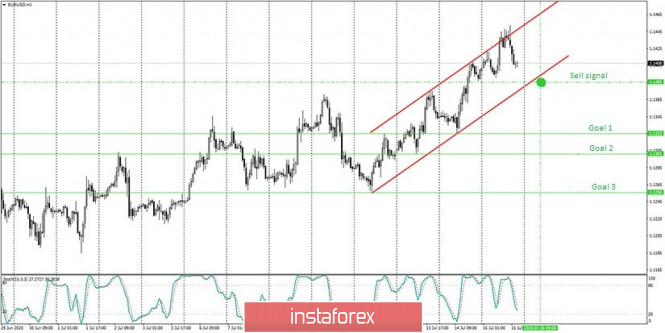
The hourly chart of the EUR/USD pair

First of all, you need to understand the news and economic reports. This type of forex market analysis can affect the movement of a currency pair in the first place. At this time, the US dollar is not confident when the second wave of the coronavirus has swept America. There are very few buyers of the dollar right now. This is because traders are afraid of the negative impact of the coronavirus on the US economy. As you know, the economy and the exchange rate of the national currency are closely linked. The stronger the economy, the more money is invested in it, the stronger the demand for the national currency. And demand, as you know, has a positive effect on the value of the currency. Few people want to buy the dollar since the coronavirus pandemic can seriously weigh on the American economy. The US government is doing everything possible to mitigate the negative effect, but the epidemic, quarantine and crisis are things that "kill" jobs, the desire of the population to work, and not just to receive unemployment benefits. As a result, the more people who are sick and are just afraid of getting sick, the fewer people who work, lead active lives, and earn and spend money, respectively. And if money is not earned or spent, then the economy is worth it. The government has to pour huge amounts of money into supporting businesses and paying unemployment benefits. But money doesn't come out of nowhere. The US budget deficit is huge. Thus, we would say that the news factor speaks in favor of the euro's growth.
Technical analysis also suggests that the euro currency will continue to increase in price (the upward movement on the chart is the euro's growth (appreciation), while the downward movement on the chart is the growth (appreciation) of the US dollar. This is evidenced by the ascending channel (red lines), within which the euro/dollar pair is traded. Thus, it is possible that today, on July 16, the pair's quotes will remain inside this channel and will not be able to exit it through its lower line. And if this does not happen, then further downward movement will be delayed for quite some time. Here are two possible versions of events:
1) If the pair touches the lower border of the channel, but cannot close lower (closing the bar below the channel line at the end of the hour), then buy with the goal of 50-60 points up. That is, after 50-60 points, we place a Take Profit order.
2) If the pair closes below the channel at the end of the next hour (we assume that this could happen near the level of 1.1385), this will be a sell signal. In this case, we recommend selling the pair, and placing Take Profit orders near the targets - the levels of 1.1325, 1.1301, 1.1256. The safest goal is the first one. During the same day, the pair usually goes the same distance (volatility). At this time, from the lowest to the highest price of each day, the pair passes approximately 75-80 points. The first goal is approximately 60 minutes away, so when it is reached, we advise you to take profit and exit the deal.
Beginners that trade in the forex market should remember that each transaction cannot be profitable. The development of a clear strategy and money management are the key to success in trading for a long period of time.